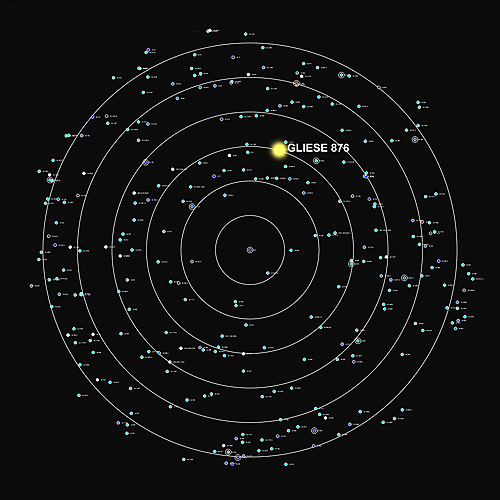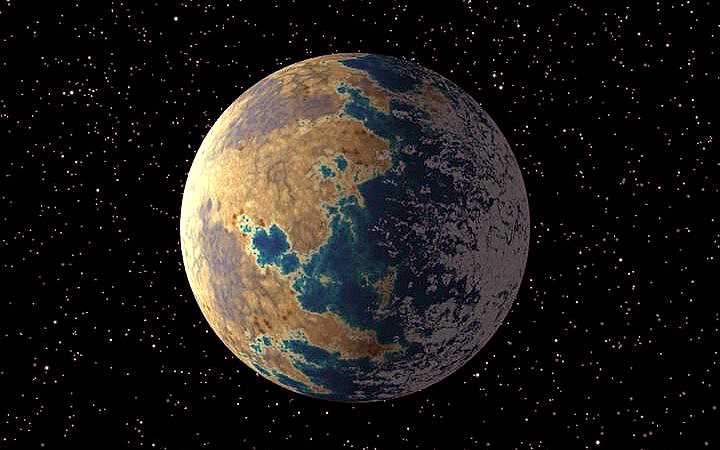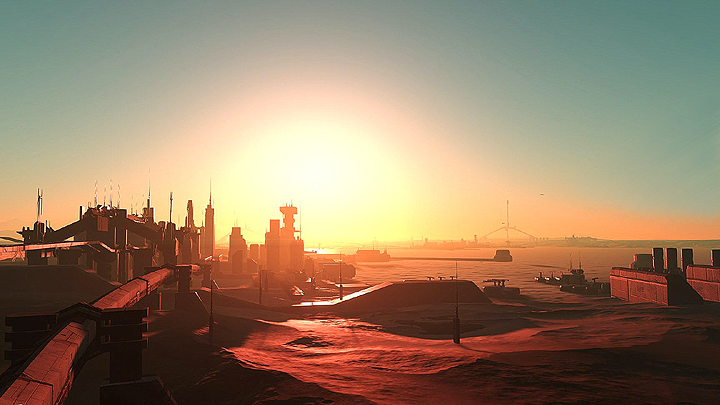
DISTANCE: 15.2 light years from Sol
NEIGHBORING SYSTEMS: Delta Pavonis 9.2 lys Tau Ceti 10 lys 61 Cygni 13.4
GLIESE 876 is a very cool and dim red dwarf with five planets in orbit which include two rocky worlds and three Jupiter-class gas giants. These gas giants all have resonant orbits causing them to line up with each other every 124 days. The star itself contains over twice the amount of heavy elements as Sol and the innermost planet has nearly seven times the mass of Earth and is greatly enriched with raw Akarium ore.
HINODE is the third planet in the system and is located so close to its sun that it is tidally locked. One side of the planet is always facing the star, while the other side remains forever in darkness. The day-side is continuously blasted by the powerful stellar winds and equatorial temperatures can reach as high as 100 C. However, this world also has an extremely strong magnetic field which not only protects it from much of the harmful UV radiation, but also helps to keep the planet’s atmosphere from being blown away into space. Heat from the red dwarf flows over the curvature of the planet and causes incessant rain storms and hurricanes to form over the vast ocean on the night-side. Only at the point furthest from the star does the surface temperature become cold enough for the ocean to freeze. This particular region is covered by a frozen landmass of ice which averages over two kilometers thick. The thin region bordering on the day and night-sides, referred to as the “Terminus” or “Polar equator”, has a temperature range of between 15 and 30 C. Upswept mountain ranges and steep cliffs, created by the perpetual high winds, are surrounded by numerous freshwater lakes and briny seas.
Diffused light from the red dwarf has caused plant photosynthesis to develop much differently here and makes indigenous foliage appear dark purple to black in color. The native wildlife is quite diverse as well and includes a unique variety of reptiles, birds, and fish.

The Tansaku-teki division of Hoshi Enterprises surveyed the Gliese 876 system in 2160 and found that metallicity levels were over twice that of Sol. What was even more surprising was the discovery of a planet orbiting a red dwarf that was capable of supporting life. As they investigated this tidally locked world, they found that the narrow perimeter between the day and night sides exhibited optimal temperatures and oxygen levels suitable for colonization. From the vantage point of an individual standing in this region, one sees an eternal sunrise with no distinct separation between day and night. Thus, Hinode, which is Japanese for “sunrise”, was chosen as the name of this newfound world. Within months, thousands of Hoshi Enterprise employees established the first permanent settlement; making this the eighth Human colony outside of Sol.
Maintaining a long-term Human colony on Hinode was, by no means, an easy endeavor. Life under a red sun presented its own series of difficulties. Higher levels of UV radiation lowered the colonists’ immune systems and, over time, could contribute to the development of severe eye damage. Medicinal treatment, derived from native plant life, was essential in combating many of these problems. Due to the incessant stellar winds which pummel the planet’s surface, wind velocities in the habitable region often reach speeds of up to 50 km/h. Simply walking out in the open can be an arduous task. For this reason, nearly all of the colony’s buildings and structures are interconnected by covered passageways. The colonists also began to wear protective goggles outside of their enclosed habitats. To this day, they are rarely seen off-world without these goggles, as their eyes have grown accustomed to the dimmer light.

A large percentage of Hinode’s inhabitants work in the local mining industry extracting raw Akarium ore from the dense, innermost planet in the system. This ore is then brought back to the colony where it is submitted to an extensive refinement process before being utilized for a variety of purposes. A great deal of this material is used in the construction of their own personal fleet of mining vessels and freighters. This also includes a handful of formidable gunships which are used to guard the system from frequent piracy.
The Hinodians, as these colonists now call themselves, are often mistaken for isolationists because they rarely venture outside their own system. They neither welcome nor discourage visitors to their world, but prefer to develop their own unique society without the outside influence of others. They have remained rather close to their sister colonies of 61 Cygni and Altair, yet their own culture and society has evolved quite differently. Instead of relying on spiritual beliefs for guidance, these individuals have learned to depend strictly on themselves and their own ingenuity. Although they have become almost completely self-sufficient with the development of large-scale aquatic farms and hydroponic gardens, resources needed for Human survival are limited and immigration laws are extremely restrictive.
Their leisure activities often consist of highly aggressive fighting competitions which require a great deal of skill, focus, and stamina. Participation in these intense tournaments is considered an honor and can even determine an individual’s overall status in their society. Hinodians are typically viewed as stoic and dispassionate while exhibiting a subtle hint of aggression at all times. They will never start a fight, but if provoked, they will finish it.
According to the official census of Hinode in 2233, this planet has a total Human population of nearly 2 million people with most of them living in the largest prefecture called, Kyokuchi. This city was constructed, over time, on top of the first temporary settlement and has become the center of both local and interstellar business on this world.

During the Zendathu-Human War, the Hinodians contributed to the conflict by providing a large portion of their own resources as well as several hundred brave volunteers. It wasn’t until after the war, when the UEC started making excessive demands on many of the outer colonies, that they truly began to distance themselves from the interstellar community as a whole. When Earth’s corporate empire ordered the ZCC-442 ROSHENKO to establish a permanent military presence in this system, the colonists considered this action to be a veiled attempt at a corporate takeover. The Hinodians gathered their entire fleet of ships in an effort to deter this incursion, but most of them were only armed with low-output mining lasers and they were no match for a war-seasoned military vessel. Putting aside their society’s proud stance of self-reliance, they sent out a request for aid, but the closest possible help was still days away. It wasn’t long before they were forced to deal with invading ground forces as well. However, due to their societies’ inclination towards aggressive fighting events; the Hinodians were able to hold their own against these intruders. In the midst of it all, two Cygnian cruisers and one Cetian vessel arrived in the system to defend the colony. Soon, the crew of the ROSHENKO, as well as its ground forces, was forced to withdraw.
Infuriated with this blatant move on the part of the UEC, the Hinodians met with representatives from their sister colonies in the 61 Cygni and Altair star systems. By the end of this diplomatic summit, a pact was signed which not only declared their independence from Earth, but also included a mutual agreement to defend each other if hostile situations ever arose. This Free Worlds League was not intended to function as a new government for these colonies. Instead, each system retained its own individual government, but now had more of an incentive to rely on each other for support.
To this day, the Hinodians rarely associate with any other colony outside of this alliance. The one exception is the people of Tau Ceti who came to their assistance in their time of need. Due to the past conflicts the Hinodians have had to endure, they have been motivated to construct the largest collection of small sentry ships in all the Human colonies.